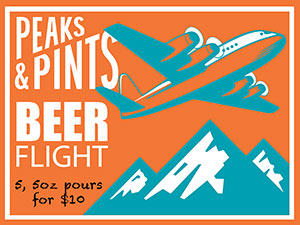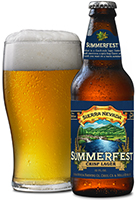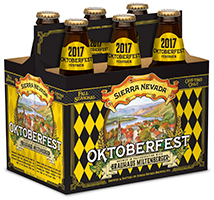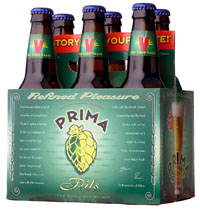 Spalt, also called Spalter Spalt, comes from the Saaz hop family. The traditional Spalt hop is grown in a town called Spalt, in Bavaria. The growth of Spalt hops can be traced back as early as the 8th century; in 1538, Prince Bishop of Eichstatt granted Spalt the first German hop seal. In the 1800s, Spalt was considered the premium German hop and demanded high prices. Much like its German Tettnanger and Saaz brothers, Spalt is also a noble hop with a low co-humolone content. Spalt is used primarily for aroma, but can be used for bittering and finishing additions. Its unique aroma differentiates it from Saaz and Tettnanger. What makes Spalt hops so special are its essential oils, like farmesene, which aren’t found in many other hop varieties. That makes for some very interesting German brews, such as Kolsch, altbiers, bocks and others. Peaks and Pints is bring the Spalt with our beer flight today, Craft Beer Crosscut 9.14.17: A Flight of Spalt. Just for fun, we’re throwing in Spalt Select in our flight too. The Hops Research Institute in Hull, German, breeds Spalt Select as a cross between Spalt and Hallertauer Mittlefrüh. Its origination is circa late 80s and was aimed to replace the Spalt variety by providing stronger growing characteristics, which is evident in its yield. The fragrance is mild and closely resembles Spalt with a slight spiciness. It is also comparable to Saaz, which makes its ideal for lagers, pilsners and other German-Style beers.
Spalt, also called Spalter Spalt, comes from the Saaz hop family. The traditional Spalt hop is grown in a town called Spalt, in Bavaria. The growth of Spalt hops can be traced back as early as the 8th century; in 1538, Prince Bishop of Eichstatt granted Spalt the first German hop seal. In the 1800s, Spalt was considered the premium German hop and demanded high prices. Much like its German Tettnanger and Saaz brothers, Spalt is also a noble hop with a low co-humolone content. Spalt is used primarily for aroma, but can be used for bittering and finishing additions. Its unique aroma differentiates it from Saaz and Tettnanger. What makes Spalt hops so special are its essential oils, like farmesene, which aren’t found in many other hop varieties. That makes for some very interesting German brews, such as Kolsch, altbiers, bocks and others. Peaks and Pints is bring the Spalt with our beer flight today, Craft Beer Crosscut 9.14.17: A Flight of Spalt. Just for fun, we’re throwing in Spalt Select in our flight too. The Hops Research Institute in Hull, German, breeds Spalt Select as a cross between Spalt and Hallertauer Mittlefrüh. Its origination is circa late 80s and was aimed to replace the Spalt variety by providing stronger growing characteristics, which is evident in its yield. The fragrance is mild and closely resembles Spalt with a slight spiciness. It is also comparable to Saaz, which makes its ideal for lagers, pilsners and other German-Style beers.
 Hofbräu München Oktoberfestbier
Hofbräu München Oktoberfestbier
6.3% ABV
Wilhelm V, Duke of Bavaria wanted a wholesome brewery in Munich. The new brewery, Hofbräu München, lurched into action in 1592 in the city’s old courts building with brewmaster of Geisenfeld Monastery, Heimeran Pongratz, to plan and supervise the construction of Hofbräuhaus (the “ducal brewery”), and to be its first master brewer. The only beer produced at that time at the company to be called Hofbräu was brown ale. While the brown ale was brewed with barley, the duke’s successor to the dukedom, Maximilian I, preferred lighter wheat beers, and he promptly ordered the brewery to make them. By 1605, the facility was producing 38,000 gallons of beer per annum, and couldn’t keep up with the demand. By 1607, a new, larger building had been constructed to house the brewing operations. By 1614, the brewery began making a darker, stronger beer called maibock. King Maximilian I Joseph of Bavaria spared no expense when his son Ludwig married his beloved Theresa of Saxony-Hildburghausen, and held a massive party for 40,000 guests on Oct. 17, 1810. Two years later, desirous of offering His Majesty a really special beverage, the Hofbräu brewers started to brew a beer specially for the festival with a deep golden color, stronger original wort and higher alcoholic content, Oktoberfestbier, using four types of hops that are grown in Hallertau, a central Bavarian region: the bitter Herkules and Magnum varieties, and the milder, aromatic varieties of Hallertauer Perle and Spalt Select. On the tongue, this marzen has buttered caramel, honey, red apples and toast on the front, while the back gains a floral noble hop bitterness.
 Sierra Nevada Summerfest
Sierra Nevada Summerfest
5% ABV, 28 IBU
The Sierra Nevada Summerfest is made with 2-row Pale and Munich malts and Perle, Spalter Select and Saaz hops. A crisp summer lager that has been around for more than 15 years, the Sierra Nevada Summerfest also lets you know that you’re drinking a real beer. With a full flavored tang hop kick, this pilsner style lager is another classic from Sierra Nevada. With light malts and light hops and spice, the crisp big bubbles make an excellent refreshing summertime lager. The lemon and malt aftertaste are very well balanced making this one of our favorite summer beers. Less-experienced drinkers may find the hoppy finish a tad too bitter, but they’ll come around.
 Sierra Nevada Oktoberfest – Brauhaus Miltenberger (2017)
Sierra Nevada Oktoberfest – Brauhaus Miltenberger (2017)
6.1% ABV, 30 IBU
For the third straight year, Sierra Nevada Brewing has collaborated with a German brewery on its fall-seasonal Oktoberfest beer. This year, second-generation brewer Brian Grossman, of Sierra Nevada, and fourth-generation Brewmaster Cornelius Faus of Miltenberg, Germany’s Brauhaus Miltenberger, have joined forces. “We tried to re-create a classic Oktoberfest beer in the true German tradition,” says Cornelius Faust, fourth-generation brewmaster for Brauhaus Miltenberger, in pre-Oktoberfest hype. “We used traditional techniques to create layers of rich malt notes that remain light and crisp to the taste. That’s the secret of an authentic fest beer — complex malt flavor in a lager that remains easy to drink while you are celebrating the Oktoberfest season.” Sierra Nevada’s Oktoberfest is a festbier, sometimes called wiesn, festibiere or Oktoberfestbier — a name that can only be used by Breweries in Munich — rather than a marzën, which is the original style of Oktoberfest. (The Beer Judge Certification Program added festbier to their guidelines in 2015 under the category “Pale Malty European Lager.”) Brewed with Tettnager, Spalter, German Select and German Magnum hops, this year’s Oktoberfest’s flavor is sweet grasses and caramel, brown leaves, lightly bitter grasses and a little bread with a quick, crisp finish.
 Victory Prima Pils
Victory Prima Pils
5.3% ABV, 44 IBU
Victory Brewing Co. is all in. The Pennsylvania brewery is committed to finding the best natural ingredients possible, a dedication that extends to their exclusive use of whole flower hops — Spalt Select, Saaz, Tettnang and Hallertau — rather than the pellets used by most breweries. The resulting brews are more delicate and nuanced, and the Prima Pils is no exception. The nose contains elusive, variable scents, none of which overpowers any of the rest; earthy, chalky, and nutty notes all complement each other. The taste moves us into the woods of Pennsylvania, with an open flavor that is as subtle as it smells. Think of a small, comforting cottage in a forest clearing, and you’ll get a sense of the Prima.
 Hair of the Dog Fred
Hair of the Dog Fred
10% ABV
Fred Eckhardt’s book, A Treatise on Lager Beers, published in 1969, was the first modern book about beer. During his stint as the Oregonian’s first beer columnist he penned The Essentials of Beer Style, helping many homebrewers understand their craft and in turn helped launch many craft brewing careers, including Hair of the Dog Brewery’s Alan Sprints, who created an American Strong Ale simply named Fred. Fred, the beer, is a deep golden color. It is made with aromatic and rye malts and includes 10 different hop varieties — Northern Brewer, Progress, First Gold, Crystal, Fuggle, Willamette, Tettnang, Chinook, Spalt, Saaz and Strisselspalt for caramel, bitter hops and some alcohol.
